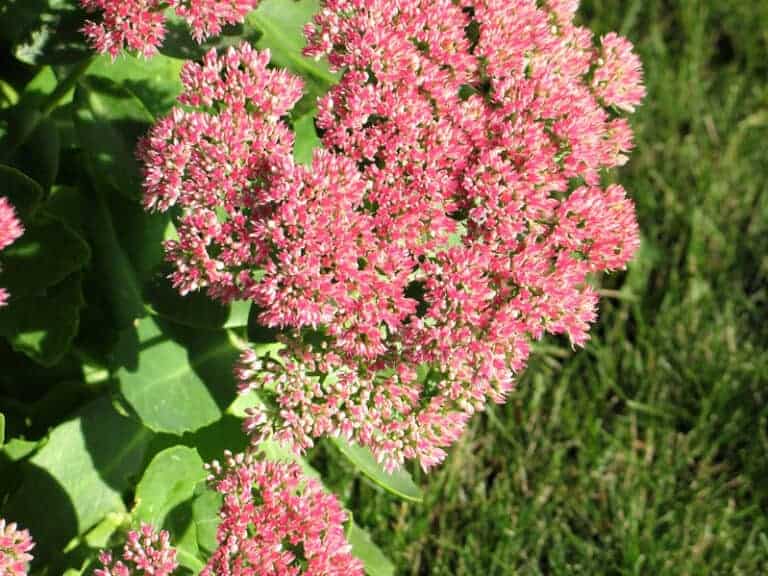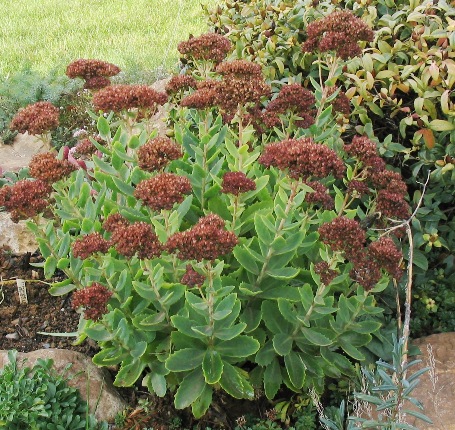
Some other insects might like to come and visit, and you might even see an occasional hummingbird as well. You will probably see many butterflies around your Autumn Joy Sedum during this time, and the flowers also produce a great amount of nectar in the late summer so you will see quite a few bees around it as well. These flowers are known to attract many visitors while they are in bloom.

The clusters themselves will grow to be about 3 to 6 inches in diameter. The flowers are tiny and star-shaped and grow in blooms or clusters that look almost broccoli-like. They will bloom for about 8 weeks in total, and never for longer than two and a half months.

The flowers on an Autumn Joy Sedum plant typically start blooming in the late summer (usually in August) and will continue to remain open into the mid-fall (probably around November). Often in this specific form of landscaping, grass is replaced with things like soil, rocks, and plants that are drought-tolerant. This particular species is commonly used in xeriscaping, which is defined as the practice of designing and creating landscapes in a way that reduces or eliminates the need for irrigation.

The stem will root very easily, and a new plant will be established in a season or two.Autumn Joy Sedum is a hybrid plant, created by crossing Hylotelephium telephium (native to Eurasia) with Hylotelephium spectabile (native to China and Korea). Autumn Joy is now one of the most popular sedum varieties available.Īutumn Joy sedum pairs well with pretty much all ornamental grasses and can live for a very long time if it is well cared for. If you would like to further ensure that the plant will start there, you can add a very thin covering of soil over the plant.įor taller sedum varieties, you can break off one of the stems and push it into the ground where you would like to grow it. They will send out roots from wherever the stem is touching the ground and root itself. For shorter varieties, simply laying the sedum on the ground where you want it to grow is normally enough to get the sedum plant started there. Overwatering and overfertilizing can hurt the plants far worse than not watering or fertilizing. Sedums need no additional water or fertilizer. Make sure the sedum that you plant is suited to your hardiness zone. Many are hardy to USDA zone 3, while others need a warmer climate. Sedum varieties also vary in their hardiness. The large majority of sedum varieties are shorter, and sedums are frequently used as groundcovers in xeriscape gardens or rock gardens. The smallest are just a few inches (8 cm.) tall, and the tallest can be up to 3 feet (1 m.).
/Autumn-Joy-sedum-big-56b6bdb93df78c0b135b92f3.jpg)
A common name for sedum is stonecrop, due to the fact that many gardeners will joke that only stones need less care and live longer. They are ideal for that part of your yard that gets too much sun or too little water to grow anything else. They will thrive in conditions that many other plants thrive in but will do just as well in less hospitable areas. When growing sedum, keep in mind that sedum plants need very little attention or care.
#ARE AUTUMN JOY SEDUM IN ROCK GARDEN HOW TO#
Learn more about how to grow sedum in the article below. With a large number of sedum varieties to choose from, you will find one that works for your garden. Growing sedum is easy so easy, in fact, that even the most novice gardener can excel at it. There are few plants more forgiving of sun and bad soil than sedum plants.


 0 kommentar(er)
0 kommentar(er)
